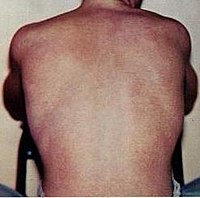
Photo from wikipedia
INTRODUCTION Tourniquet application is an urgent life-saving procedure. Previous studies demonstrated several drawbacks in tourniquet design and application methods that limit their efficacy; among them, loose application of the device… Click to show full abstract
INTRODUCTION Tourniquet application is an urgent life-saving procedure. Previous studies demonstrated several drawbacks in tourniquet design and application methods that limit their efficacy; among them, loose application of the device before windlass twisting is a main pitfall. A new generation of modern combat tourniquets was developed to overcome these pitfalls. The objective of this study was to assess the effectiveness of three new tourniquet designs: the CAT Generation 7 (CAT7), the SAM Extremity Tourniquet (SAM-XT), and the SOF Tactical Tourniquet Wide (SOFTT-W) as well as its correlation to the degree of slack. MATERIALS AND METHODS The three tourniquet models were applied in a randomized sequence on a HapMed leg tourniquet trainer, simulating an above-the-knee traumatic amputation by 60 military medicine track cadets. Applied pressure, hemorrhage control status, time until the bleeding stopped, estimated blood volume loss, and slack were measured. RESULTS The mean (±SD) pressure applied using the SAM-XT (186 mmHg ±63) or the CAT7 (175 mmHg ±79) was significantly higher compared to the pressure applied by the SOFTT-W (104 mmHg ±101, P < 0.017), with no significant difference between the first two (P > 0.05). Hemorrhage control rate was similar (P > 0.05) with SAM-XT (73.3%) and CAT7 (67.7%), and both were significantly better than the SOFTT-W (35%, P < 0.017). Slack was similar between CAT7 and SAM-XT (5.2 mm ± 3.4 vs. 5 mm ± 3.5, P > 0.05), yet significantly lower compared to the SOFTT-W (9 mm ± 5, P < 0.017). A strong negative correlation was found between slack and hemorrhage control rate (3.2 mm ± 1.5 mm in success vs. 10.5 mm ± 3.4 mm in failure, P < 0.001) and applied pressure (Pearson's correlation coefficient of -0.83, P < 0.001). CONCLUSIONS Both SAM-XT and CAT7 demonstrated a better pressure profile and hemorrhage control rate compared to SOFTT-W, with no significant difference between the two. The better outcome measures were strongly correlated to less slack.
Journal Title: Military medicine
Year Published: 2020
Link to full text (if available)
Share on Social Media: Sign Up to like & get
recommendations!